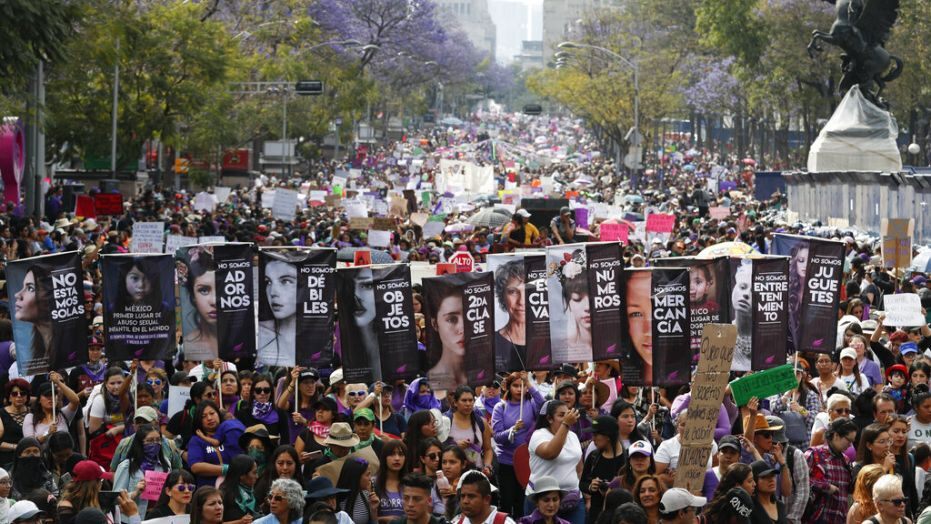Millions of Mexican women strike on ‘The Day Without Us’

A few minutes every morning is all you need.
Stay up to date on the world's Headlines and Human Stories. It's fun, it's factual, it's fluff-free.
Millions of women in Mexico took part in a strike on March 9 to protest against rising levels of gender-based violence.
The strike, called “The Day Without Us," saw women from across the country stay home from work and school. The intention was to show what life would be like if women disappeared from society. The day before the protest, thousands took to the street to mark International Women’s Day.
Alongside protesting the rising levels of violence against women, the strike also highlighted the perceived failure of the Mexican government to confront the issue. Some activists believe that a lack of governmental action is responsible for the femicide crisis, which has seen more than 10 women murdered every day.
What happened on March 9?
The strike had a noticeable impact, according to a BBC report. There were scarcely any women on public transport, in shopping centers or cafes and restaurants. Many schools and universities closed because of the protest after female students skipped class to strike. Indigenous Zapatista women from the south of the country journeyed to the capital to be part of the protest.
Major businesses, including Walmart and Bimbo, supported the strike and told female employees to stay home, assuring them they would not face punishment for missing work. Other parts of society supported the action, too. According to The New York Times, many public officials, celebrities and church leaders backed the protest. The Guardian reported that some activists said the outpouring of support showed the strength of the movement. But others argued backing from corporations and politicians diluted some of its ideological force.
Alongside staying home from work and school, “The movement also urged us to use as little social media as possible, as well as streaming websites, so that it could be noticeable as well,” said Michelle, who took part in the strike.
Officials don’t know how many women took part in the strike. The economic impact of the women who left the workforce was also unclear. But Concanaco Servytur, one of Mexico’s largest business groups, estimated that if every woman took part, it could cost the economy up to $1.37 billion.
Although the strike was widespread, not every woman joined. Some could not afford to lose a day’s wages or had small businesses to run. Others said turning up to work, especially in dangerous areas, was a protest in of itself. And the BBC reported that some women who did go to work on March 9 wore purple clothing or ribbons to show their support.

Why did women strike?
According to The Guardian, the strike took place because there has been a surge in femicides. Gender-motivated killings of women have increased 137% in the past five years, government statistics show, with an estimated 10 women per killed per day. Of the approximately 4,000 women murdered in 2019, 1,006 women were victims of femicide. One report puts the number of women murdered so far this year at 386.
Frequent episodes of violence, including the high-profile murders of a 7-year-old girl called Fatima and of 25-year-old Ingrid Escamilla, have sparked outrage in Mexico. According to the Guardian, the grief about the killings has inspired new passion for the country’s women’s movement.

Many women took part in the strike because they no longer feel safe. Speaking to the Guardian, Elsa Arísta González, who founded a Facebook group to report disappearances and abuse in the city of Nezahualcóyotl, in Mexico state, said: “We used to be able to walk home from school alone and leave open the door to your house. Not anymore."
A lack of safety for women also motivated Michelle to protest on Monday.
“I’m just a woman who, because of my gender, has had to keep informed of these issues to keep myself safe and join the cause,” she said.
There is also the feeling that the authorities are not doing enough to stop violence against women or prosecute the perpetrators. Even though police in Mexico are investigating about 700 femicides, activists point out that most murders cases go unsolved and victims often remain missing.
Similar protests on February 14 denounced gender-based violence. Demonstrators protested outside Mexico’s presidential palace after the death of Ingrid Escamilla and following the publication of pictures of her corpse in some national newspapers.
But violence is not limited to just women. Last year, Mexico saw almost 30,000 murders in total, making it the most violent peacetime society in the world.

Activists say government response is lacking
President Andrés Manuel López Obrador, the left-wing nationalist who came to power in a landslide in 2018, has faced mounting criticism over his response to the issue of violence against women.
According to Dr Paulina García-Del Moral, an assistant professor at the University of Guelph who has researched gendered violence in Mexico, those who commit acts of violence against women can often get away with it because of the government’s inaction.
The president has been dismissive of the movement to tackle gender-based violence. He has linked femicides to the “neoliberal policies" of previous governments and suggested that the women’s protests are part of a rightwing conspiracy. He made similar comments after the March 9 protests. According to Obrador, women were free to protest, but he claimed that some “wanted our administration to fail." The Mexican president also said that the March 9 strike, as well as the International Women’s Day protests, would not change his administration’s policy on tackling the issue.

Comments ()